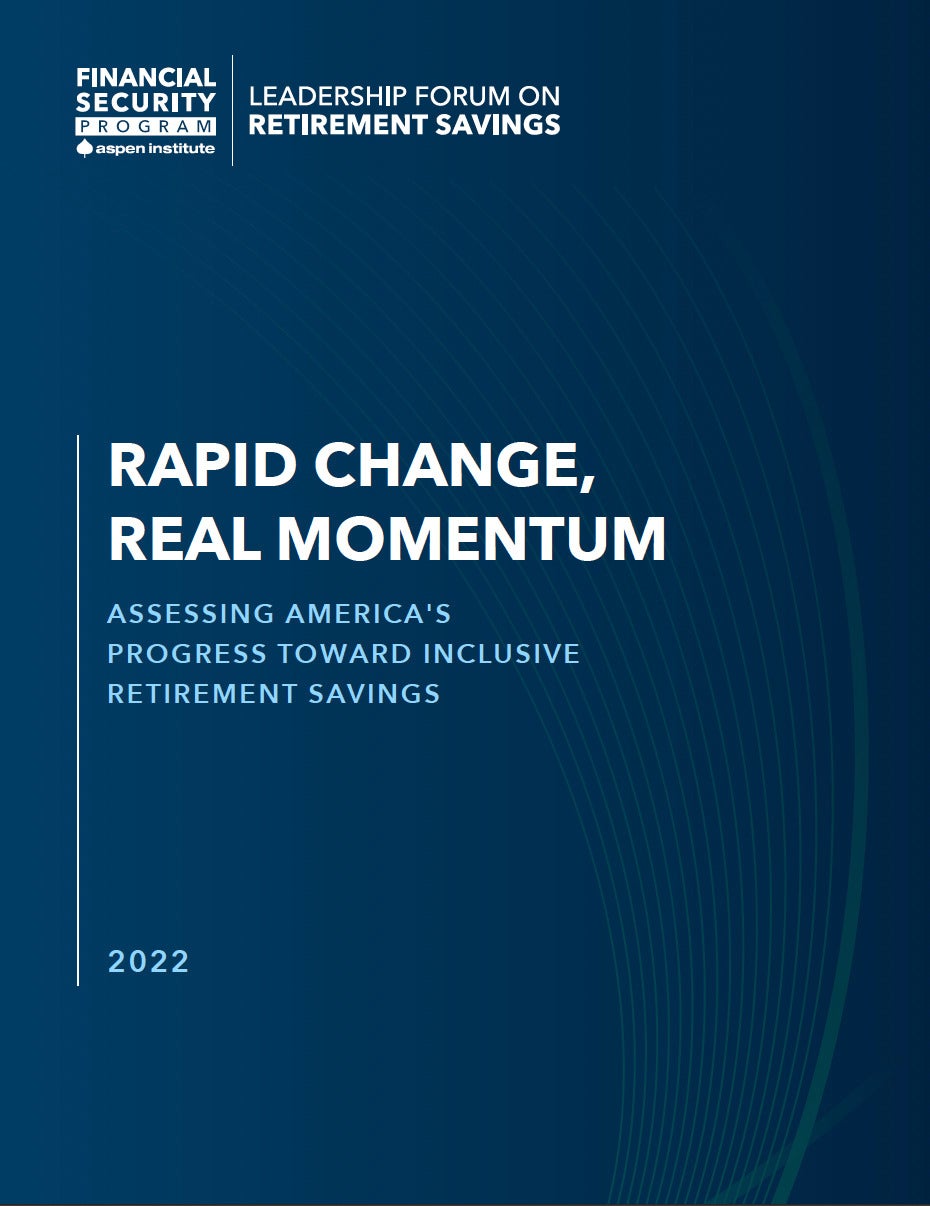The momentum around workplace emergency savings accounts (ESAs) has only intensified since the passage of SECURE Act 2.0 in 2022, which included key emergency savings provisions. Beginning in 2024, employers can automatically enroll employees into emergency savings accounts within the structure of their retirement savings plans. As years of experience with 401(k) automatic enrollment have shown, the ability to automatically enroll participants into workplace plans is essential for employees at all income levels to participate successfully in workplace saving.
The good news is that employers haven’t been waiting for 2024 to help their employees save for emergencies. Even before the provisions from SECURE 2.0 go into effect, innovative employers, nonprofits, and fintechs have been launching “out-of-plan” ESAs as a benefit to their workers. “Out-of-plan” refers to savings accounts not connected to a retirement plan; “in-plan” accounts exist within the structure of a retirement plan but are separate from pre-tax retirement savings. For many employers, out-of-plan solutions are appealing because these accounts are often hosted through banking platforms that can provide greater ease and accessibility of the funds for users, and employers do not have the fiduciary responsibility for the account. Unfortunately, there is not the same national, legal framework allowing employers to automatically enroll employees into out-of-plan emergency savings accounts as now exists for in-plan.
Given the financial security opportunity that widespread access to workplace emergency savings represents, we at the Aspen Institute Financial Security Program (Aspen FSP)–along with leading experts in our field–are eager to advance both the policy and market solutions required to accelerate the delivery of high-quality emergency savings tools to all households. Now, as we enter a post-SECURE 2.0 world, we offer policymakers and employers fresh evidence sourced from leading experts that supports four pillars of the emergency savings field. We also want to look ahead, illuminating paths toward more effective emergency savings options for everyone–whether in-plan or out-of-plan in the workplace or–particularly for non-traditional workers and older adults–outside the workplace altogether.
How Workplace ESAs Function
First, a definition: A workplace emergency savings account is an account containing liquid funds used to help households manage a financial shock and reduce the risk of hardship.
High-quality workplace ESAs:
- Operate via payroll deduction, making the process of ongoing saving automatic once people are enrolled;
- Offer principal protection, so that the funds will be there when an employee needs them;
- Protect funds by having FDIC or similar insurance; and
- Offer liquidity and immediate accessibility.
Other important features can help strengthen a workplace ESA: automatic enrollment, financial incentives (e.g., one-time employer contribution or an employer match), no fees, no account minimums, and clear and consistent communication about the program.
Leading employers have been implementing workplace emergency savings solutions in the last several years, with major companies like Starbucks, Humana, UPS, Voya, Delta, ADP, and numerous others rolling out solutions, reaching millions of workers. Cross-sector leadership has helped accelerate uptake as well, including BlackRock’s Emergency Savings Initiative (ESI), which has reached more than 10 million people and resulted in over $2 billion saved through ESI savings interventions. And this is likely just the start of the growth as more companies seek to offer this benefit.
This employer-driven activity is happening for good reason: In a Bipartisan Policy Center survey, people trust their employers, one of a handful of institutions that people have higher confidence in when it comes to their finances. Sixty percent of employees actively want their employer to offer emergency savings as a workplace benefit, with high interest among younger workers and workers of color.
The workplace is an important, though not the only, place to deploy emergency savings accounts. As the landscape of workplace emergency savings takes shape, there is increasing interest in delivering emergency savings tools to workers outside of a traditional workplace setting, including older Americans. In a recent survey from Pew, 66.4% of nontraditional workers stated that emergencies are a major barrier toward building retirement savings, and 79.4% of respondents stated that pre-retirement access to savings to cope with an emergency was important to them. This segment of the workforce, which is less likely to be financially secure than traditional workers, represents an important area of focus and innovation for the financial services industry and policymakers alike.
Fresh Data Supports Four Pillars of Workplace ESAs
1) Automatic Enrollment Matters for Successful Emergency Savings
SECURE 2.0 has enabled automatic enrollment into in-plan accounts starting in 2024, and thankfully, two distinct research trials from emergency savings innovator Nest Insight (UK) can shed light on the impact of automatic enrollment on ESA uptake, usage, and impact on financial well-being. The first is a “new worker trial” started in November 2021, in which an employer set up employee payroll autosave into personal savings accounts with a credit union. The second is a “benefits app user trial” launched in October 2022, in which two employer clients of a financial services app have had payroll autosave offered to their employees through the app.
In both programs, automatic enrollment increased participation dramatically. In the new worker trial, 1% of employees participated in opt-in emergency savings before the trial. After automatic enrollment was implemented, 47% participated. Results in the benefits app user trial showed a similar increase: 16% of employees participated in opt-in emergency savings. After automatic enrollment was implemented, 71% participated.
2) People with Low and Moderate Incomes Want to–and Can–Save
Recent research shows that workers across the income spectrum save in ESAs, including people earning low and moderate incomes. Recent work by SaverLife shows promising results among people with low and moderate incomes. The median SaverLife user has an income between $25,000 and $35,000 per year; two-thirds of new members have less than $100 in liquid savings at the time of sign-up. Within six months of enrollment with SaverLife, approximately two-thirds of users had already deposited at least $500 in emergency savings. Within 21 months of enrollment, over two-thirds of users have at least one month’s worth of liquid emergency savings.
Similarly, Sunny Day Fund, an out-of-plan workplace emergency savings platform, has found that their users with an hourly wage of $10 to $12 are participating in emergency savings programs–just with relatively smaller deposits.
However, many LMI households are challenged to save by asset limit requirements that are often associated with eligibility for public benefit programs like the Supplemental Nutrition Assistance Program, Supplemental Security Income, and Temporary Assistance for Needy Families. Participants can face savings limits as low as $1,000 in order to maintain benefit program eligibility; research shows that these asset limits do, in fact, restrict savings rates and discourage people from opening and using important financial tools like bank accounts.
3) Emergency Savings Support Retirement Savings
We’re also seeing an important interplay between retirement savings and emergency savings in the workplace: these savings accounts provided by employers work with each other, rather than against each other.
A survey conducted by Aspen FSP, DCIIA, Morningstar, and NORC at the University of Chicago found that having at least $1,000 in emergency savings cut in half the likelihood of workers withdrawing from retirement funds during the economic crisis caused by the pandemic. Similarly, research from Commonwealth and DCIIA shows that—across the income spectrum—people with emergency savings are less likely to take a 401(k) loan or hardship withdrawal or to pause or reduce contributions in their retirement savings.
Employees also say they want emergency savings in addition to retirement savings. A study conducted by the Bipartisan Policy Center reveals that 61% of workers with access to retirement benefits would deposit into emergency accounts if offered—in addition to their continued deposits to retirement accounts. Interestingly, a joint survey between Commonwealth and Saverlife found that 30% of respondents indicated a willingness to contribute more to existing retirement accounts if they were offered liquid savings options (such as emergency savings accounts)—with very few respondents claiming that they would deposit less in their retirement accounts.
4) Emergency Savings Accounts Should Be Designed for a “Build, Use, Rebuild” Cycle
Across these types of ESAs, the field has found that accounts work best when they are designed for savers to accumulate a balance, access the funds when an emergency strikes, and automatically start rebuilding funds in the account. We have called this the “build, use, rebuild” cycle, and leading employers are beginning to note that this process shapes effective program design and should guide how we measure the success of ESAs.
One of the two Nest Insight trials found that people who were automatically enrolled used their savings: In one program, four months after signing up, roughly 15% of people in the opt-out group had made a withdrawal, compared with 3% in the opt-in group and 2% in the active choice group. They were building, using, and rebuilding.
Qualitative research conducted by Nest Insight found that employees use the accounts as a safety net, with one in the new worker trial saying: “It makes me not worry as much because I know if something does happen with my car, even something as silly as my kettle, I know I need £20 to buy one—it’s just little things like that, that little peace of mind if something does happen, I have got that to fall back on.”
The critical story here is not only what it takes to amass savings, but how that savings functions—over and over again—as a tool that helps people manage day-to-day financial needs, build resilience, and stay on track for their longer-term goals.
What’s Ahead in Workplace Emergency Savings
If 2023 was any indication, 2024 will only drive more momentum for automatic enrollment into emergency savings accounts. With these key new provisions in SECURE 2.0 set to take effect, and with growing evidence of emergency savings as an effective workplace benefit, we predict that many more employers will offer emergency savings to their employees, empowering workers to address their short-term needs and build financial security.
Next, we need policy solutions that allow for automatic enrollment into out-of-plan emergency savings vehicles. While SECURE 2.0 allows for automatic enrollment into in-plan emergency savings, we know millions of workers are still unable to benefit from that, given that 57 million workers lack access to a workplace retirement account and, by default, would lack access to an opt-out in-plan emergency savings option. We need to build on this success of in-plan automatic enrollment from SECURE 2.0 and support policymakers, employers, and innovators as they work to enable automatic enrollment into out-of-plan emergency savings accounts.
Additionally, we need policy action to remove the explicit barriers to saving that threatens to blunt the impact of these innovations for those who could most benefit. Currently, momentum is building behind legislative efforts to reform asset limits in the Supplemental Security Income program, which have remained at $2,000 for individuals since 1984. Research from the JPMorgan Chase Policy Center concludes that modernizing asset limits in that program would not only raise the ceiling of savings allowed by beneficiaries of that program but increase their work hours and earnings that could be devoted to savings by reducing concerns they might run afoul of eligibility rules.
There remain millions of workers who will not be reached through in-plan or out-of-plan emergency savings accounts because they are not tied to the traditional workforce, including independent contractors, contingent and gig workers, adults no longer participating in the workforce, and many part-time workers. To that end, Aspen FSP and other leaders in the field are actively exploring opportunities for innovation for older adults in particular. In early Q1 2024, Aspen FSP will publish a research brief highlighting the unique, unmet emergency savings needs of older Americans and underscoring the mismatch—and therefore the innovation opportunity—between the current supply of emergency savings solutions and the liquidity needs of older adults as they navigate financial shocks.
As 2024 begins, with more people in the U.S. gaining access to ESAs to help them weather financial shocks, we believe the future is looking bright for policy and market-based solutions to accelerate access to automatic enrollment into emergency savings to all households in America, regardless of whether and where they work.
About the Emergency Savings Cohort
The emergency savings cohort organized by Aspen FSP is comprised of leaders and experts in the emergency savings field, including the Bipartisan Policy Center, BlackRock, Commonwealth, DCIIA, ideas42 Policy Lab, Nest Insight, SaverLife, SecureSave, and others, who contribute to sharing insights and key learnings about the field as well as policy and market innovations.


